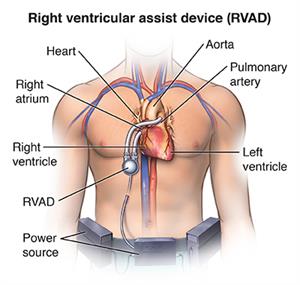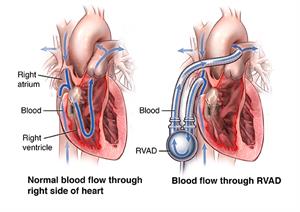What is right ventricular assist device (RVAD) implantation?
A ventricular assist device helps your heart pump blood when the pumping muscle has become weak. A right ventricular assist device (RVAD) pumps blood from your right ventricle or right atrium into your pulmonary artery and to the lungs.

Your healthcare provider implants the pump close to your heart. The power source is located outside of your body. It is connected to a pump through a small hole in your abdomen. Both the pump and the power source of some temporary ventricular assist devices are located outside of your body. Tubes connect the pump to your heart through small holes in your abdomen.
Your surgeon implants the device during open heart surgery. During this procedure, the surgeon redirects the major arteries that take blood in and out of your heart to the pump. The pump, in turn, pushes the blood through your heart and out to the lungs.
Why might I need RVAD implantation?
A ventricular assist device stabilizes your heart function after injury, such as a heart attack. It's also used if you have severe heart failure that does not improve with medicines. It can also keep your heart working while you wait for a heart transplant. This may be called “bridge” therapy. For most people, an RVAD is temporary. Your surgeon usually places it after implanting a left ventricular assist device (LVAD) or doing another type of heart surgery. Your healthcare provider also uses an RVAD to stabilize your condition during an emergency, while your medical team evaluates your health and the best option for treatment.
What are the risks of RVAD implantation?
RVAD implantation is major surgery and requires general anesthesia. This medicine puts you to sleep. Any general anesthesia carries the risk of heart or brain injury. Major surgery also carries the risk of blood clots forming during or after surgery. These clots can break free and travel to your lungs, causing a pulmonary embolism, or to your brain, causing a stroke.
Other risks of this surgery include:
- Infection, including sepsis
- Bleeding
- Device failure
- Abnormal heart rhythm (arrhythmia)
- Infection of your heart tissue (endocarditis)
- Kidney damage
- Bleeding in the brain (cerebral hemorrhage)
There may be other risks, depending on your specific health condition. Discuss any concerns with your healthcare provider before the procedure.
How do I get ready for RVAD implantation?
If you need an RVAD in an emergency, you will be unable to prepare for it. If your surgery is planned, your healthcare provider might give you a complete evaluation, do special X-rays, blood tests, and other tests to check the health of your lungs and heart. Your healthcare provider may also request an echocardiogram and cardiac catheterization. An echocardiogram is an ultrasound of the heart that uses sound waves to make images of your heart. Cardiac catheterization is used to look at circulation through the arteries in the heart muscle and to measure the amount of pressure inside the heart chambers and the lungs.
Other steps may include the following:
- Your healthcare provider will explain the procedure to you. Ask questions if you have any.
- You will be asked to sign a consent form that gives your permission to do the procedure. Read the form carefully and ask questions if something is unclear.
-
Follow any directions you are given for not eating or drinking before surgery.
- Tell your healthcare provider right away if you are pregnant or think you could be.
- You should tell your healthcare
provider:
- If you are sensitive or allergic to any medicines, iodine, latex, tape, or anesthesia (local and general)
- About all prescription and over-the-counter medicines and herbal supplements that you are taking. You may need to stop some of these before the procedure. Know what medicines to stop and when to stop them.
- If you have a history of bleeding disorders or if you are taking any blood-thinners, aspirin, or other medicines that affect blood clotting. Your healthcare provider may do a blood test to see how long it takes your blood to clot.
- If you smoke, stop smoking as soon as possible before the procedure. This may improve your chances for a successful recovery from surgery and benefit your overall health status.
Based on your health condition, your healthcare provider may have other instructions for you.
What happens during RVAD implantation?
The operation may take between 4 and 6 hours. Your surgeon may stop your heart during the surgery. In this case, a heart-lung bypass machine will do the work of your heart, keeping oxygen-rich blood flowing throughout your body during surgery. The surgery usually proceeds as follows:
- You will be asked to remove any jewelry or other objects that may interfere with the procedure.
- You will change into a hospital gown and empty your bladder.
- An IV (intravenous) line will be started in your arm or hand. Additional catheters may be inserted in your neck and wrist to monitor the status of your heart and blood pressure and to take blood samples.
- The anesthesiologist will give you some medicine to help you relax and fall asleep. They will continuously monitor your heart rate, blood pressure, breathing, and blood oxygen level during the surgery. Once you are sedated, they will insert a breathing tube through your throat into your lungs and connect you to a ventilator, which will breathe for you during the surgery.
- A catheter will be inserted into your bladder to drain urine.
- The skin over the surgical site will be cleaned with an antiseptic solution.
- The surgeon will make a cut (incision) in the front of your chest, down through your chest wall to reach your heart. The surgeon will insert tubes into your heart, so that a heart-lung bypass machine can keep your blood moving.
- Your surgeon will insert a tube into your right atrium or ventricle and attach it to a pump. An additional outflow tube from the pump will be attached to your pulmonary artery. The pump will circulate blood in the right side of the heart, through the pump, and out the pulmonary artery to your lungs to get oxygen.
- The pump will be implanted either inside your upper belly or on the outside of your skin. Once all the attachments are completed, the pump will be turned on to let blood flow through the heart and lungs.
- Once the procedure has been completed, the blood circulating through the bypass machine will be allowed to re-enter your heart. The tubes to the bypass machine will be removed.
- Your surgeon will insert tubes into your chest to drain blood and other fluids from around the heart. These tubes will be connected to a suction device to drain fluids away from the heart.
- A tube will be inserted through your mouth or nose into your stomach to drain stomach fluids.
- Your surgeon will close the incisions with sutures or surgical staples and apply a sterile dressing.
What happens after RVAD implantation?
In the hospital
How long you stay in the hospital will depend on your overall condition after surgery.
- For the first few days, you may be in the intensive care unit (ICU) where you can be monitored closely until your vital signs have stabilized.
- As you recover, your healthcare provider will remove the tubes that give you nourishment, help you breathe, and drain fluids from your body.
- Your healthcare provider may place temporary pacing wires on your heart during the surgery. They will remove these wires once it is determined that your heart rhythm is stable and you no longer need them.
- Physical rehabilitation (cardiac rehab or physical therapy) and pulmonary rehabilitation are important for your long-term recovery. You will begin a step-wise program of increasing time and intensity of activity in preparation for going home.
- Healthcare providers will help you care for your incision, manage pain, and get you up walking.
- Before you leave the hospital, you will learn how to use and care for the RVAD. Before you leave the hospital, you and your loved ones should be able to use the device correctly and know what to do in emergencies.
At home
Once your healthcare providers feel that you have recovered enough, you may be discharged home. Follow all your instructions for medicines, pain control, diet, activity, and wound care. Make sure to keep all your follow-up appointments. Your healthcare provider may prescribe blood-thinning (anticoagulant) medicines. These help prevent blood clots from forming. Understand how to take them and what side effects they might cause.
If you are waiting for a heart transplant, keep in close contact with your transplant center.
Other common instructions after surgery include:
- Walk as much as possible.
- Don't do any heavy lifting. Your surgeon will provide a time line for certain lifting restrictions.
- Gradually go back to your normal activities as instructed. Ask your healthcare provider about work and sexual activity. You won’t be able to drive for a period of time after the surgery. This will let your breastbone (sternum) and muscles of the chest wall heal.
- Check your wounds for any sign of swelling, redness, bleeding, or discharge and report these to your medical and surgical team.
- Tell your healthcare provider about any increasing pain, fever, chest pain, or shortness of breath.
- Eat a heart-healthy diet and stay at a healthy weight. Eat foods that are low in salt, cholesterol, and fat. Try to eat fruits, vegetables, and lean meats.
- Don’t smoke and stay away from secondhand smoke. Stay away from all tobacco products, including electronic cigarettes.
Next steps
Before you agree to the test or the procedure, make sure you know:
- The name of the test or procedure
- The reason you are having the test or procedure
- What results to expect and what they mean
- The risks and benefits of the test or procedure
- What the possible side effects or complications are
- When and where you are to have the test or procedure
- Who will do the test or procedure and what that person’s qualifications are
- What would happen if you did not have the test or procedure
- Any alternative tests or procedures to think about
- When and how you will get the results
- Who to call after the test or procedure if you have questions or problems
- How much you will have to pay for the test or procedure
